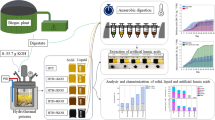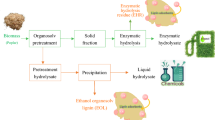Abstract
Purpose
The purpose of this work is to investigate a new class of solvents for separating secondary agricultural residues, which have already been transported to processing centers, into individual biomass components. Using biocompatible deep eutectic solvents (DES) on secondary agricultural residues could valorize these wastes into bioproducts by separating lignin from cellulose. DES pretreatment to achieve this separation involves chemicals that are less hazardous for the environment than other pretreatments.
Methods
Five deep eutectic solvents that are biocompatible have been investigated for their ability to deconstruct rice hulls and sugarcane bagasse. Mass yield, enzymatic hydrolysis of the pretreated biomass, fiber analysis, pKa analysis and Fourier transform infrared spectroscopy (FTIR) were performed to explore the effect of the DES on these secondary agricultural residues.
Results
Experimental results confirmed that the DES formic acid:choline chloride (FA:CC), lactic acid:choline chloride, and acetic acid:choline chloride were effective in removing lignin, thus concentrating cellulose in both pretreated biomass. Addition of water precipitated lignin from the spent DES, as confirmed by FTIR. However, the higher pKa DES lactic acid:betaine and lactic acid:proline had little effect on rice hulls or sugarcane bagasse. FA:CC was the most effective of the DES tested in preparing the biomass for enzymatic saccharification. All the effectively pretreated samples had higher inorganic content compared to the relevant raw biomass.
Conclusions
DES with stronger acidity (lower pKa) were found to be more efficient for delignification, leading to higher glucose yield. Further work is required to determine how inorganics affect waste biomass pretreatment.
Graphic Abstract






Similar content being viewed by others
References
Ferreira, E.M., Pires, A.V., Susin, I., Mendes, C.Q., Gentil, R.S., Araujo, R.C., Amaral, R.C., Loerch, S.C.: Growth, feed intake, carcass characteristics, and eating behavior of feedlot lambs fed high-concentrate diets containing soybean hulls. J. Anim. Sci. 89(12), 4120–4126 (2011)
Baba, M., Nasiru, A., Karkarna, I.S., Muhammad, I.R., Rano, N.B.: Nutritional evaluation of sweet potato vines from twelve cultivars as feed for ruminant animals. Asian J Anim. Vet. Adv. 13(1), 25–29 (2018)
Zadrazil, F., Puniya, A.K.: Studies on the effect of particle size on solid-state fermentation of sugarcane bagasse into animal feed using white-rot fungi. Bioresour. Technol. 54(1), 85–87 (1995). https://doi.org/10.1016/0960-8524(95)00119-0
Lim, J.S., Manan, Z.A., Alwi, S.R.W., Hashim, H.: A review on utilisation of biomass from rice industry as a source of renewable energy. Renew. Sustain. Energy Rev. 16(5), 3084–3094 (2012). https://doi.org/10.1016/j.rser.2012.02.051
Ouyang, Y.S.: Mesomechanical characterization of in situ rice grain hulls. Trans. Asae 44(2), 357–367 (2001)
Reza, M.T., Uddin, M.H., Lynam, J.G., Coronella, C.J.: Engineered pellets from dry torrefied and HTC biochar blends. Biomass Bioenergy 63, 229–238 (2014). https://doi.org/10.1016/j.biombioe.2014.01.038
Glasser, W.G.: About making lignin great again—some lessons from the past. Front. Chem. (2019). https://doi.org/10.3389/fchem.2019.00565
Catalan, L.J.J., Liang, V., Jia, C.Q., Walton, C.: Effects of process changes on concentrations of individual malodorous sulphur compounds in ambient air near a Kraft pulp plant in Thunder Bay, Ontario, Canada. WIT Trans. Ecol. Environ. 101, 437–447 (2007). https://doi.org/10.2495/air070431
Ruiz, H.A., Da Silva, F.F.M., Vicente, A.A., Teixeira, J.A., Ruzene, D.S., Silva, D.P.: Development and characterization of an environmentally friendly process sequence (autohydrolysis and organosolv) for wheat straw delignification. Appl. Biochem. Biotechnol. 164(5), 629–641 (2011). https://doi.org/10.1007/s12010-011-9163-9
Brandt, A., Gräsvik, J., Hallett, J.P., Welton, T.: Deconstruction of lignocellulosic biomass with ionic liquids. Green Chem. 15(3), 550–583 (2013). https://doi.org/10.1039/c2gc36364j
Lee, Y.R., Row, K.H.: Comparison of ionic liquids and deep eutectic solvents as additives for the ultrasonic extraction of astaxanthin from marine plants. J. Ind. Eng. Chem. 39, 87–92 (2016). https://doi.org/10.1016/j.jiec.2016.05.014
Francisco, M., van den Bruinhorst, A., Kroon, M.C.: New natural and renewable low transition temperature mixtures (LTTMs): screening as solvents for lignocellulosic biomass processing. Green Chem. 14(8), 2153–2157 (2012). https://doi.org/10.1039/c2gc35660k
Chen, W., Wang, J., Jiang, J., Zhao, X., Mu, T., Xue, Z.: Investigation on the thermal stability of deep eutectic solvents. Wuli Huaxue Xuebao/Acta Phys. Chim. Sin. 34(8), 904–911 (2018). https://doi.org/10.3866/PKU.WHXB201712281
Zhu, J., Xu, Y., Feng, X., Zhu, X.: A detailed study of physicochemical properties and microstructure of EmimCl-EG deep eutectic solvents: their influence on SO2 absorption behavior. J. Ind. Eng. Chem. 67, 148–155 (2018). https://doi.org/10.1016/j.jiec.2018.06.025
Gorke, J., Srienc, F., Kazlauskas, R.: Toward advanced ionic liquids. Polar, enzyme-friendly solvents for biocatalysis. Biotechnol. Bioprocess Eng. 15(1), 40–53 (2010). https://doi.org/10.1007/s12257-009-3079-z
Lamers, P., Roni, M.S., Tumuluru, J.S., Jacobson, J.J., Cafferty, K.G., Hansen, J.K., Kenney, K., Teymouri, F., Bals, B.: Techno-economic analysis of decentralized biomass processing depots. Bioresour. Technol. 194, 205–213 (2015). https://doi.org/10.1016/j.biortech.2015.07.009
Yu, D., Mou, H., Fu, H., Lan, X., Wang, Y., Mu, T.: “Inverted” Deep Eutectic Solvents Based on Host-Guest Interactions. Chem. Asian J. 14(23), 4183–4188 (2019)
Yu, D., Mou, H., Zhao, X., Wang, Y., Mu, T.: Eutectic molecular liquids based on hydrogen bonding and π–π interaction for exfoliating two-dimensional materials and recycling polymers. Chem. Asian J. 14(19), 3350–3356 (2019)
Yu, D., Mu, T.: Strategy to form eutectic molecular liquids based on noncovalent interactions. J. Phys. Chem. B 123(23), 4958–4966 (2019)
Yiin, C.L., Quitain, A.T., Yusup, S., Sasaki, M., Uemura, Y., Kida, T.: Characterization of natural low transition temperature mixtures (LTTMs): Green solvents for biomass delignification. Bioresour. Technol. 199, 258–264 (2016). https://doi.org/10.1016/j.biortech.2015.07.103
Perez-Sanchez, M., Sandoval, M., Hernaiz, M.J., de Maria, P.D.: Biocatalysis in biomass-derived solvents: the quest for fully sustainable chemical processes. Curr. Org. Chem. 17(11), 1188–1199 (2013)
Huo, Z., Fang, Y., Yao, G., Zeng, X., Ren, D., Jin, F.: Improved two-step hydrothermal process for acetic acid production from carbohydrate biomass. J. Energy Chem. 24, 207–212 (2015). https://doi.org/10.1016/s2095-4956(15)60302-3
Reichert, J., Wasserscheid, P., Albert, J., Brunner, B., Jess, A.: Biomass oxidation to formic acid in aqueous media using polyoxometalate catalysts—boosting FA selectivity by in-situ extraction. Energy Environ. Sci. 8(10), 2985–2990 (2015). https://doi.org/10.1039/c5ee01706h
Yang, L., Su, J., Carl, S., Lynam, J.G., Yang, X., Lin, H.: Catalytic conversion of hemicellulosic biomass to lactic acid in pH neutral aqueous phase media. Appl. Catal. B 162, 149–157 (2015). https://doi.org/10.1016/j.apcatb.2014.06.025
Kumar, A.K., Parikh, B.S., Shah, E., Liu, L.Z., Cotta, M.A.: Cellulosic ethanol production from green solvent-pretreated rice straw. Biocatal. Agric. Biotechnol. 7, 14–23 (2016). https://doi.org/10.1016/j.bcab.2016.04.008
Xu, G.C., Ding, J.C., Han, R.Z., Dong, J.J., Ni, Y.: Enhancing cellulose accessibility of corn stover by deep eutectic solvent pretreatment for butanol fermentation. Bioresour. Technol. 203, 364–369 (2016). https://doi.org/10.1016/j.biortech.2015.11.002
Zhao, Z., Chen, X., Ali, M.F., Abdeltawab, A.A., Yakout, S.M., Yu, G.: Pretreatment of wheat straw using basic ethanolamine-based deep eutectic solvents for improving enzymatic hydrolysis. Bioresour. Technol. 263, 325–333 (2018). https://doi.org/10.1016/j.biortech.2018.05.016
Plaza, A., Tapia, X., Yañez, C., Candia, O., Vilches, F., Cabezas, R., Romero, J.: Obtaining hydroxytyrosol from olive mill waste using deep eutectic solvents and then supercritical CO2. Waste Biomass Valorization (2019). https://doi.org/10.1007/s12649-019-00836-1
Zhang, C.-W., Xia, S.-Q., Ma, P.-S.: Facile pretreatment of lignocellulosic biomass using deep eutectic solvents. Bioresour. Technol. 219, 1–5 (2016)
Hou, X.-D., Li, A.-L., Lin, K.-P., Wang, Y.-Y., Kuang, Z.-Y., Cao, S.-L.: Insight into the structure-function relationships of deep eutectic solvents during rice straw pretreatment. Bioresour. Technol. 249, 261–267 (2018). https://doi.org/10.1016/j.biortech.2017.10.019
Vigier, K.D.O., Chatel, G., Jérôme, F.: Contribution of deep eutectic solvents for biomass processing: opportunities, challenges, and limitations. ChemCatChem 7(8), 1250–1260 (2015). https://doi.org/10.1002/cctc.201500134
Lynam, J.G., Kumar, N., Wong, M.J.: Deep eutectic solvents’ ability to solubilize lignin, cellulose, and hemicellulose; thermal stability; and density. Bioresour. Technol. 238, 684–689 (2017). https://doi.org/10.1016/j.biortech.2017.04.079
Liu, Q., Mou, H., Chen, W., Zhao, X., Yu, H., Xue, Z., Mu, T.: Highly efficient dissolution of lignin by eutectic molecular liquids. Ind. Eng. Chem. Res. 58(51), 23438–23444 (2019)
Liu, Q., Zhao, X., Yu, D., Yu, H., Zhang, Y., Xue, Z., Mu, T.: Novel deep eutectic solvents with different functional groups towards highly efficient dissolution of lignin. Green Chem. 21(19), 5291–5297 (2019)
Xing, W., Xu, G., Dong, J., Han, R., Ni, Y.: Novel dihydrogen-bonding deep eutectic solvents: pretreatment of rice straw for butanol fermentation featuring enzyme recycling and high solvent yield. Chem. Eng. J. 333, 712–720 (2018)
Yu, Q., Zhang, A., Wang, W., Chen, L., Bai, R., Zhuang, X., Wang, Q., Wang, Z., Yuan, Z.: Deep eutectic solvents from hemicellulose-derived acids for the cellulosic ethanol refining of Akebia’herbal residues. Bioresour. Technol. 247, 705–710 (2018)
Sluiter, A., Hames, B., Ruiz, R., Scarlata, C., Sluiter, J., Templeton, D., Crocker, D.: Determination of structural carbohydrates and lignin in biomass. Lab. Anal. proced. 1617, 1–16 (2008)
Arafat, S., Kumar, N., Wasiuddin, N.M., Owhe, E.O., Lynam, J.G.: Sustainable lignin to enhance asphalt binder oxidative aging properties and mix properties. J. Clean. Prod. 217, 456–468 (2019). https://doi.org/10.1016/j.jclepro.2019.01.238
Kumar, N., Muley, P.D., Boldor, D., Coty IV, G.G., Lynam, J.G.: Pretreatment of waste biomass in deep eutectic solvents: conductive heating versus microwave heating. Ind. Crops Prod. 142, 111865 (2019)
Ioelovich, M.: Correlation analysis of enzymatic digestibility of plant biomass. Biomass Convers. Bioref. 4(3), 269–275 (2014). https://doi.org/10.1007/s13399-013-0109-z
Zhao, X., Zhang, L., Liu, D.: Biomass recalcitrance. Part I: the chemical compositions and physical structures affecting the enzymatic hydrolysis of lignocellulose. Biofuels Bioprod. Bioref. 6(4), 465–482 (2012)
Kumar, A.K., Parikh, B.S., Pravakar, M.: Natural deep eutectic solvent mediated pretreatment of rice straw: bioanalytical characterization of lignin extract and enzymatic hydrolysis of pretreated biomass residue. Environ. Sci. Pollut. Res. 23(10), 9265–9275 (2016)
Procentese, A., Johnson, E., Orr, V., Campanile, A.G., Wood, J.A., Marzocchella, A., Rehmann, L.: Deep eutectic solvent pretreatment and subsequent saccharification of corncob. Bioresour. technol. 192, 31–36 (2015)
Zulkefli, S., Abdulmalek, E., Rahman, M.B.A.: Pretreatment of oil palm trunk in deep eutectic solvent and optimization of enzymatic hydrolysis of pretreated oil palm trunk. Renew. Energy 107, 36–41 (2017)
Yang, H., Wang, L., Jia, L., Qiu, C., Pang, Q., Pan, X.: Selective decomposition of cellulose into glucose and levulinic acid over fe-resin catalyst in NaCl solution under hydrothermal conditions. Ind. Eng. Chem. Res. 53(15), 6562–6568 (2014). https://doi.org/10.1021/ie500318t
Acknowledgements
The authors want to sincerely acknowledge the Louisiana Board of Regents Research competitive subprogram (Award# LEQSF(2017-20)-Rd-A11) and the Region 6 Environmental Protection Agency P2 Grant [Grant Number NP-01F55301-0] for support of this project. The authors appreciate the help of Dr. Adarsh Radadia and Dr. Sven Eklund.
Author information
Authors and Affiliations
Contributions
NK: conceptualization, supervision, formal analysis, writing. JGL: project administration, supervision, writing—review & editing, funding acquisition. RG: data curation, visualization. JDS: investigation, data curation, visualization, GGC, IV: investigation, data curation, visualization.
Corresponding author
Ethics declarations
Conflict of interest
The authors declare that they have no known competing financial interests or personal relationships that could have appeared to influence the work reported in this paper.
Additional information
Publisher's Note
Springer Nature remains neutral with regard to jurisdictional claims in published maps and institutional affiliations.
Electronic supplementary material
Below is the link to the electronic supplementary material.
Rights and permissions
About this article
Cite this article
Kumar, N., Gautam, R., Stallings, J.D. et al. Secondary Agriculture Residues Pretreatment Using Deep Eutectic Solvents. Waste Biomass Valor 12, 2259–2269 (2021). https://doi.org/10.1007/s12649-020-01176-1
Received:
Accepted:
Published:
Issue Date:
DOI: https://doi.org/10.1007/s12649-020-01176-1




